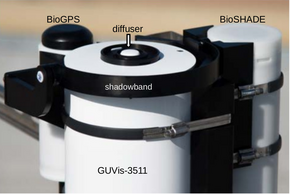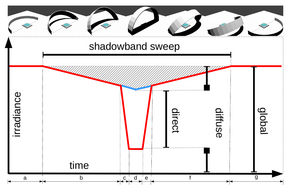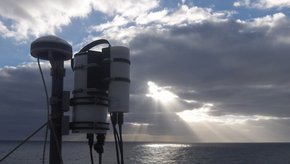The GUVis-3511 shadow-band radiometer built by Biospherical Instruments Inc. is operated by TROPOS since 2014. The GUVis-3511 radiometer is a multichannel filter instrument (Seckmeyer et al., 2010) with 18 narrow spectral channels, ranging from 305 to 1640 nm with a bandwidth of approximately 10 nm, plus one unfiltered broadband channel with a spectral response given by its silicon detector (e.g., King & Myers, 1997). The radiometer is equipped with a computer-controlled shadow-band accessory, called BioSHADE (Morrow et al., 2010). The band is made of black anodized aluminium, is 2.5 cm wide and has a diameter of 26.7 cm. Due to its geometry, the shadow-band occults a solid angle of 15° of the sky from the sensor in zenith position. The width of the BioSHADE shadow-band is broader compared to bands used in similar instruments, for example the MFRSR (3.3°; Harrison et al.,1994) or the TCRSR (2° and 5°; Bartholomew et al., 2011).
Shadow-band radiometer
The GUVis-3511 typically samples at 15 Hz at all times, also during a shadow-band rotation. The band rotates 180° over the radiometer diffuser at a constant speed, such that at least 5 data points are sampled during the time when all parts of the diffuser are shaded by the band. For measuring global irradiance, the band is stowed below the horizon of the instrument’s diffuser after one sweep during the split time to the next sweep. An idealized time series of one shadow-band sweep is outlined in the figure. From this time-series, the global, diffuse and direct spectral irradiance is retrieved, as described in Witthuhn et al. (2017). With this technique, the global and diffuse irradiance are observed with a single sensor, which avoids calibration inconsistencies and improves accuracy of direct to diffuse irradiance ratio products. Also, the position of the sun has not to be known during the measurements. Therefore, this instrument is well suited for operations on a moving platform (e.g., ship).
Observations of spectral irradiance, AOD and AE are conducted with the GUVis within in the framework of Shipborne facility to investigate continuously the transfer of energy and material between ocean and atmosphere (OCEANET) (Macke, 2009) during the Atlantic transect cruises with the German research vessel Polarstern operated by the Alfred-Wegener Institute (AWI) since 2014. In addition, the radiometer was also used on various TROPOS field measurement campaigns on land between the ship cruises (e.g., MelCol, Cy-CARE, MetPVNet). This constantly growing data set is used to partially close known gaps of satellite reference observations over the ocean (Witthuhn et al., 2020).
Technical details
| Spectral channels | 18x [310 - 1640nm] |
| 1x unfiltred | |
| FWHM | 9 - 28nm |
| Sample rate | 15 Hz |
| Shadow-band rotation period | 40 s |
| Temporal resolution | 1 min |
| Shading angle | 12-15° |
| Weight | 5 kg |
| Dimensions | 24x24x36 cm |



